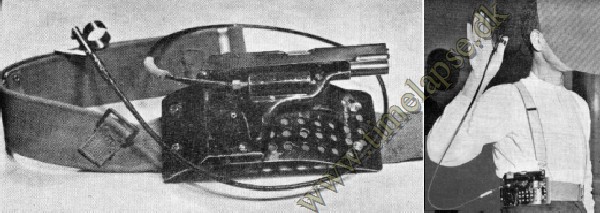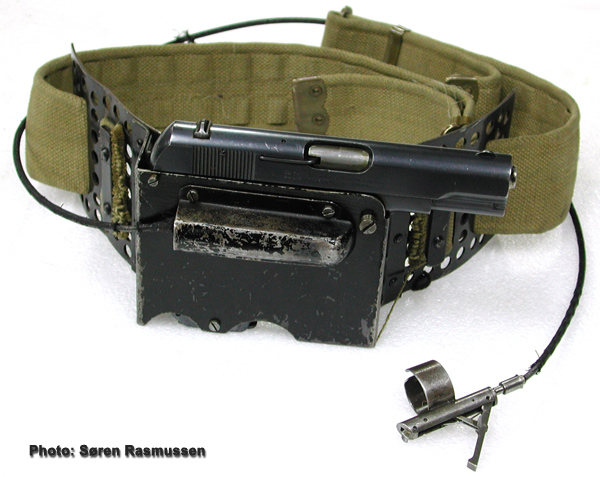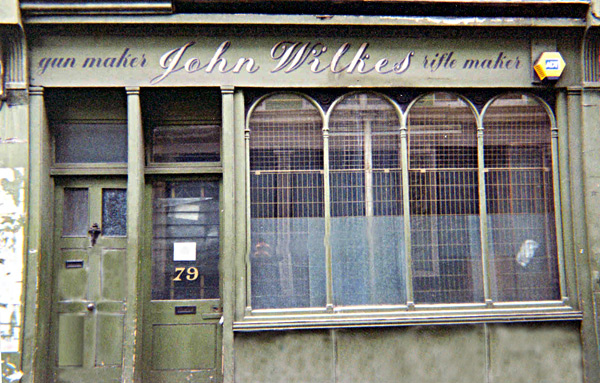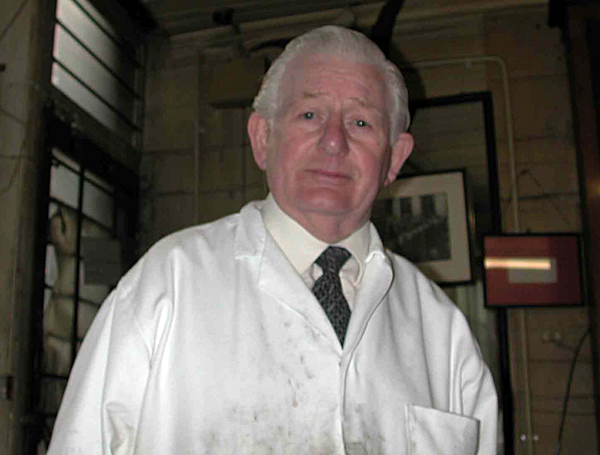|
MODELS
We are aware of two different versions both using the COLT Hammerless 1903 .32ACP caliber pistol subsequently referred to as Mk.I & Mk. II. The one found on Carl Bruhn named Mk. I and the one produced by John Wilkes from the Wilkes Bros. Gun Shop in Soho, London named Mk. II.

The photo shows the RCP Mk.I found on Agent Bruhn’s body. Note the carefully crafted cover plate compared to the Mk.II version produced by Wilkes Bros.
In the Mk. I model one will notice that the cover plate is carefully bent and shaped so it follows the pistols contours, also the platform on which the pistol is attached is small and handy and the corners are curved leaving the impression of a professional production.

The photo shows the RCP produced by John Wilkes from Wilkes Bros. gun shop. Note the coarse-cut cover plate compared to the Mk.I version. Also note the cuts in the cover plate next to the magazine well making it easier to reload.

The Wilkes Bros. Gun Shop in 79 Beak Street, Soho, London anno November 2002.
On the Mk.II version the cover plate is flat, rectangular and disproportionately big which leaves the impressions of a hastily produced rig. However we know that the Mk.I version was encumbered with defects such as the platform carrying the pistol being too small causing the pistol rig to be unstable during recoil and if the cable twisted the pistol would not fire.
John Wilkes corrected these defects and the rig as a whole by making the platform bigger and made a modification to the trigger unit on the finger which allowed the cable to rotate freely without locking the trigger cable. According to John Wilkes only 40 – 50 RCP´s were produced.

The late Mr. John Wilkes from Wilkes Bros. Gun Shop anno 2002.
The Mk. I model was according to John Wilkes brought to the Wilkes gun shop by Major Ridout and Lt. Col. Tomlinson who requested that the gun be produced by John Wilkes*. This information is rather interesting seen in light of newly released documents from the Public Record Office (PRO) in England. The book "SOE The Scientific Secrets", by Fredric Boyce and Douglas Everett, features a reprint of a document that was produced towards the end of the war to ensure that the right persons would be properly credited for their inventions.
Among the entries on the list can be found: "Remote Control Firing Mechanism For Pistol". The inventors are listed as Lt. Col. J.R.V Dolphin and Mr. E. Norman respectively. We now know that Lt. Col. John Robert Vernon Dolphin was Commander of Station IX (The Frythe). Station IX busied itself with the research and development of weapons and gear to be distributed to the resistance movements in the occupied countries and Eric Norman was one of its foremost weapons
experts. In that light it is tempting to draw the conclusion that the RCP was invented and further developed at Station IX only later to be handed over to Station VI (Bride Hall) being the weapons section and as such responsible for the further production. This is where Lt. Col. Tomlinson enters the scene.
As chief of Station VI he approached John Wilkes with the aim of getting a proper production started, the result of which is the Mk II as we know it today.
* According to an interview between Mr. Ian Skennerton and Mr. De Lisle, he explains that he offered to improve the design and that he actually have made about 24 of them while he was off for a few days on sick leave. We asked Mr. Wilkes about this but he stated that Mr. De Lisle had nothing to do with the production or development of the RCP, but confirmed that Mr. De Lisle was present at the shop working on one of his silencer projects when Major Ridout and Lt. Col. Tomlinson entered the store requesting that the RCP to be produced by Mr. Wilkes.
STATUS
It has turned out to be very difficult to find any reliable information or evidence to prove its existence and the only model in existence that we are aware of is on storage at SATIC (Small Arms Technical Information Centre) in Leeds, U.K. formerly known as the MOD Pattern Room in the Enfield Building in Nottingham, U.K. Unfortunately there is no access to the public.
In 1980 the Imperial War Museum and the Pattern Room asked john Wilkes if they could borrow his original blueprints of the RCP. We enquired with both museums but neither could claim possession of the drawings!
The biggest mystery is what actually happened to the Mk.I´s carried by the agents Carl Johan Bruhn and Mogens Hammer and the one in his luggage. We know that the two were seized by the German authorities but we haven’t been able to find them in any museums or archives in Denmark. It is possible that they were sent to Germany along with Mr. Müller’s report. After all this was a completely new weapon never seen before. The one carried by Mogens Hammer has never turned up either but witness reports reveals that he was wearing it in Copenhagen after his escape.
DISTRIBUTION
No one knows for sure how many RCP´s were used on missions, but it is certain that Carl Bruhn and Mogens Hammer were issued one each for the Chilblain operation. It is rumoured that the two Czechoslovakian S.O.E. agents who on May 27. 1942 assassinated Reinhard Heydrich in Prague (Operation Anthropoid) were issued at least one RCP.
|




